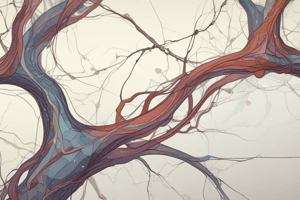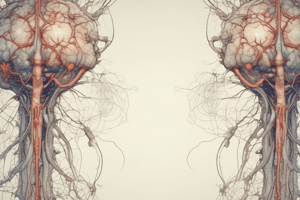Podcast
Questions and Answers
What pathological process primarily underlies the muscle weakness observed in Duchenne Muscular Dystrophy (DMD)?
What pathological process primarily underlies the muscle weakness observed in Duchenne Muscular Dystrophy (DMD)?
- Progressive degeneration and necrosis of muscle fibers due to genetic mutation. (correct)
- Autoimmune destruction of acetylcholine receptors at the neuromuscular junction. Reduced muscle contraction.
- Selective loss of motor neurons in the spinal cord and brainstem.
- Inflammation of peripheral nerves leading to impaired nerve conduction.
Which of the following pathological mechanisms is most closely associated with the development of Amyotrophic Lateral Sclerosis (ALS)?
Which of the following pathological mechanisms is most closely associated with the development of Amyotrophic Lateral Sclerosis (ALS)?
- Formation of neurofibrillary tangles and amyloid plaques in the brain.
- Peripheral nerve demyelination impairing nerve conduction velocity.
- Chronic inflammation of muscle tissue leading to progressive muscle degeneration.
- Progressive degeneration of both upper and lower motor neurons in the brain and spinal cord. (correct)
A patient presents with muscle weakness primarily in the distal extremities, accompanied by sensory loss in a 'stocking-glove' distribution. This presentation is indicative of which type of nerve involvement?
A patient presents with muscle weakness primarily in the distal extremities, accompanied by sensory loss in a 'stocking-glove' distribution. This presentation is indicative of which type of nerve involvement?
- Myopathy, directly affecting the muscle fibers.
- Radiculopathy, affecting nerve roots as they exit the spinal cord.
- Polyneuropathy, affecting multiple peripheral nerves. (correct)
- Mononeuropathy, affecting a single nerve.
In the context of lower motor neuron lesions, what distinguishes the pattern of weakness and atrophy associated with anterior horn cell pathology from that of peripheral nerve pathology?
In the context of lower motor neuron lesions, what distinguishes the pattern of weakness and atrophy associated with anterior horn cell pathology from that of peripheral nerve pathology?
Which of the following conditions primarily affects the neuromuscular junction, leading to muscle weakness that worsens with activity and improves with rest?
Which of the following conditions primarily affects the neuromuscular junction, leading to muscle weakness that worsens with activity and improves with rest?
Spinal Muscular Atrophy (SMA) predominantly involves which of the following components of the motor unit?
Spinal Muscular Atrophy (SMA) predominantly involves which of the following components of the motor unit?
A patient presents with lower motor neuron signs, including weakness, atrophy, fasciculations, and hyporeflexia. Imaging reveals a lesion affecting the anterior horn of the spinal cord. Which condition is most consistent with these findings?
A patient presents with lower motor neuron signs, including weakness, atrophy, fasciculations, and hyporeflexia. Imaging reveals a lesion affecting the anterior horn of the spinal cord. Which condition is most consistent with these findings?
Following a motorcycle accident, a patient exhibits weakness in the muscles innervated by the radial nerve, but no other neurological deficits. This presentation is most indicative of what type of peripheral nerve involvement?
Following a motorcycle accident, a patient exhibits weakness in the muscles innervated by the radial nerve, but no other neurological deficits. This presentation is most indicative of what type of peripheral nerve involvement?
Which of the following is a characteristic feature of lower motor neuron lesions but NOT of upper motor neuron lesions?
Which of the following is a characteristic feature of lower motor neuron lesions but NOT of upper motor neuron lesions?
Which of the following best describes the underlying pathology in Charcot-Marie-Tooth disease?
Which of the following best describes the underlying pathology in Charcot-Marie-Tooth disease?
How does damage to the anterior horn cells from lower motor neuron lesions affect the distribution of extremity muscle impairment?
How does damage to the anterior horn cells from lower motor neuron lesions affect the distribution of extremity muscle impairment?
A patient is diagnosed with a lower motor neuron lesion affecting the spinal roots. What sensory changes should be anticipated in this patient?
A patient is diagnosed with a lower motor neuron lesion affecting the spinal roots. What sensory changes should be anticipated in this patient?
How would the deep tendon reflexes be affected in a patient with a lower motor neuron lesion affecting the peripheral nerves?
How would the deep tendon reflexes be affected in a patient with a lower motor neuron lesion affecting the peripheral nerves?
Which neuropathic conditions directly affects the insulation surrounding the axon leading to slowed nerve conduction?
Which neuropathic conditions directly affects the insulation surrounding the axon leading to slowed nerve conduction?
Which of the following is the most likely cause of muscular dystrophy?
Which of the following is the most likely cause of muscular dystrophy?
After sustaining a traumatic injury, a patient exhibits signs of brachial neuralgia. What specific findings would suggest that the cervical spinal roots are involved?
After sustaining a traumatic injury, a patient exhibits signs of brachial neuralgia. What specific findings would suggest that the cervical spinal roots are involved?
In the context of lower motor neuron lesions, what distinguishes the features of muscle weakness associated with Neuromuscular Junction disorders from Muscle diseases?
In the context of lower motor neuron lesions, what distinguishes the features of muscle weakness associated with Neuromuscular Junction disorders from Muscle diseases?
What is the primary difference between mononeuropathy and polyneuropathy regarding the extent of nerve involvement?
What is the primary difference between mononeuropathy and polyneuropathy regarding the extent of nerve involvement?
If a patient has a condition affecting the lateral cell groups associated with lower motor neurons, what specific movements would be most impacted?
If a patient has a condition affecting the lateral cell groups associated with lower motor neurons, what specific movements would be most impacted?
In cases of suspected lower motor neuron disease affecting the anterior horn cells, how might the distribution of muscle involvement help differentiate between Spinal Muscular Atrophy (SMA) and Amyotrophic Lateral Sclerosis (ALS)?
In cases of suspected lower motor neuron disease affecting the anterior horn cells, how might the distribution of muscle involvement help differentiate between Spinal Muscular Atrophy (SMA) and Amyotrophic Lateral Sclerosis (ALS)?
Flashcards
What is a motor unit?
What is a motor unit?
A functional unit including an alpha motor neuron and all the muscle fibers it innervates.
Anterior Horn Cell Lesion
Anterior Horn Cell Lesion
Weakness and atrophy in a segmental or focal pattern with fasciculations. Sensation remains intact.
Spinal Roots and Nerves Lesion
Spinal Roots and Nerves Lesion
Weakness and atrophy in a root-innervated pattern, sometimes with fasciculations. Corresponding dermatomal sensory deficits.
Peripheral Nerve Mononeuropathy
Peripheral Nerve Mononeuropathy
Signup and view all the flashcards
Peripheral Nerve Polyneuropathy
Peripheral Nerve Polyneuropathy
Signup and view all the flashcards
Neuromuscular Junction Lesion
Neuromuscular Junction Lesion
Signup and view all the flashcards
Muscle Lesion
Muscle Lesion
Signup and view all the flashcards
LMN Diseases: ALS
LMN Diseases: ALS
Signup and view all the flashcards
LMN Diseases: Pure LMN involvement
LMN Diseases: Pure LMN involvement
Signup and view all the flashcards
LMN Diseases: Intervertebral Disc Disorders
LMN Diseases: Intervertebral Disc Disorders
Signup and view all the flashcards
LMN Diseases: Spondylosis
LMN Diseases: Spondylosis
Signup and view all the flashcards
Peripheral Neuropathy
Peripheral Neuropathy
Signup and view all the flashcards
Mononeuropathy
Mononeuropathy
Signup and view all the flashcards
Peripheral Neuropathy: Classification
Peripheral Neuropathy: Classification
Signup and view all the flashcards
Motor Neuron Diseases
Motor Neuron Diseases
Signup and view all the flashcards
Amyotrophic Lateral Sclerosis
Amyotrophic Lateral Sclerosis
Signup and view all the flashcards
Study Notes
- Lower Motor Neuron (LMN) lesion is being discussed
Motor Unit
- A motor unit consists of the anterior horn cell, its axon, and the muscle fibres it innervates.
- A lesion at any point along the motor unit can result in lower motor neuron signs.
- The location of the lesion impacts the specific signs and symptoms observed.
Anterior Horn Cell (1)
- Associated motor deficits include weakness, atrophy in a segmental or focal pattern, and fasciculations.
- Sensation remains intact.
- Deep tendon reflexes are decreased.
- Polio and amyotrophic lateral sclerosis are examples of potential causes.
Spinal Roots and Nerves (2)
- Motor deficits include weakness and atrophy in a root-innervated pattern, along with possible fasciculations.
- Corresponding dermatomal sensory deficits are present.
- Deep tendon reflexes are decreased.
- A herniated cervical or lumbar disc can be a cause.
Peripheral Nerve: Mononeuropathy (3)
- Motor deficits include weakness and atrophy in a peripheral nerve distribution, sometimes with fasciculations.
- Sensory loss follows the pattern of the affected nerve.
- Deep tendon reflexes are decreased.
- Trauma is a potential cause.
Peripheral Nerve: Polyneuropathy (4)
- Motor deficits involve weakness and atrophy more distally than proximally, with possible fasciculations.
- Sensory deficits commonly exhibit a stocking-glove distribution.
- Deep tendon reflexes are decreased.
- Peripheral polyneuropathy due to alcoholism or diabetes is a possible cause.
Neuromuscular Junction (5)
- Fatigue is more prominent than actual weakness.
- Sensation remains intact.
- Deep tendon reflexes are typically normal.
- Myasthenia gravis is a relevant condition.
Muscle (6)
- Weakness is usually more pronounced proximally than distally; fasciculations are rare.
- Sensation is intact.
- Deep tendon reflexes may be normal or decreased.
- Muscular dystrophy is a potential cause.
Lower Motor Neuron Diseases
- Alpha-motor neurons, which are located in the anterior horn of the spinal cord (anterior horn cells), cluster in a specific pattern.
- Medial cell groups associate with muscles of the spine and trunk.
- Lateral cell groups associate with muscles of the extremities.
- The lateral cell mass subdivides and the ventrolateral group innervates extensor muscles.
LMN Diseases: Anterior Horn Cell
- LMN diseases include progressive degenerative diseases of the motor neurons, except for polio.
- Includes combined LMN and UMN involvement (Amyotrophic lateral sclerosis) pure LMN involvement (SMA type I, SMA type II, SMA type III, SMA type IV)
LMN Diseases: Spinal Roots
- Includes intervertebral disc disorders (Acute disc prolapse, Herniated Nucleus Pulposus), Spondylosis (Lumbar Spondylosis Cauda Equina, Sciatica), Cervical Spondylosis and Brachial Neuralgia.
LMN Diseases: Peripheral Nerves
- Peripheral Neuropathy is inflammation or degeneration of peripheral/cranial nerves, impairing conductivity, leading to motor, sensory, and autonomic manifestations.
- Includes mononeuropathy (affecting a single nerve trunk in one limb) and mononeuropathy multiplex (affecting more than one nerve trunk).
- Peripheral neuropathy classifications are acute, chronic, subacute, intermittent; inherited vs acquired; axonal vs demyelinating; sensory vs motor
LMN Diseases: Peripheral Nerves
- Includes diabetic neuropathy, acute infective polyneuritis, Landry-Guillain-Barre Syndrome, chronic immune demyelinating polyneuropathy (CIDP), and hereditary motor sensory neuropathy (Charcot Marie Tooth)
LMN Diseases: NMJ Disorders
- Includes Myasthenia Gravis
LMN Diseases: Muscle Diseases
- Includes congenital (centronuclear) myopathies, metabolic/enzyme deficiency, secondary myopathies, muscular dystrophy (Duchenne Muscular Dystrophy (DMD) Becker muscular dystrophy (BMD), facioscapulohumeral muscular dystrophy, limb-girdle muscular dystrophy, myotonic dystrophy), myositis (Polymyositis, Dermatomyositis)
Motor Neuron Diseases
- Refers to a group of purely motor degenerative disorders involving selective loss of upper and/or lower motor neurons that innervate musculature of the limb and bulbar regions.
Motor Neuron Diseases: Amyotrophic Lateral Sclerosis
- Motor degenerative disorders involve selective loss of function of upper and lower motor neurons.
- AKA Lou Gehrig's disease.
- Pathogenesis includes the Oxidative stress theory: Disruption of cell detoxification mechanisms oxidative stress on neurons neuronal degeneration, and loss of certain neurotrophic factors, factors are responsible for maintenance and survival of.
Studying That Suits You
Use AI to generate personalized quizzes and flashcards to suit your learning preferences.




